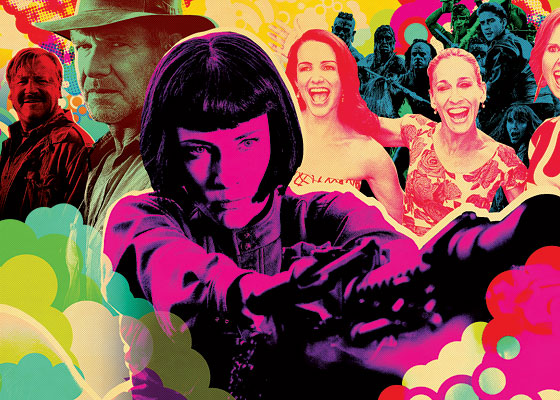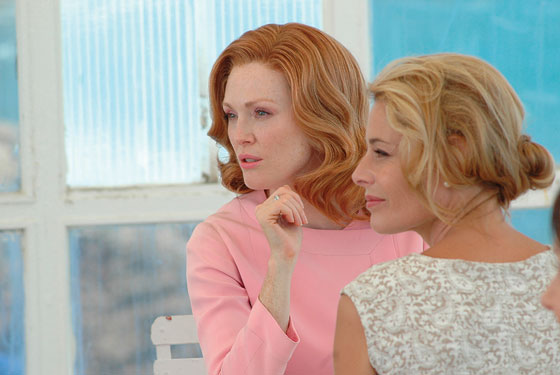
Has there ever been a TV series more polarizing than Sex and the City? It polarized me: First it drove me crazy (like itching powder), now I’m madly in love with it. It’s hard to feel halfway about these women and their unabashed materialism, overprivilege, and self-indulgence, their overdependence on and objectification of men. But what a hoot it is to see babes, for once, doing the objectifying—and talking dirty and sleeping around and measuring their fantasies against the sobering truth of male emotional insufficiency. If the core friendship of Carrie, Miranda, Samantha, and Charlotte is the biggest fantasy of all—they complement one another perfectly; they’re never too competitive—it’s a moving design for living: existential haute couture.
The movie, which reunites the whole cast, even if the other actresses aren’t palsy-walsy with Kim Cattrall, has the delish/insufferable mixture about right. (It wouldn’t be SATC if it weren’t a little annoying.) Sex and the City: The Motion Picture (not the actual title) is a joyful wallow. And it’s more: In this summer of do-overs (The Incredible Hulk, a new Batman versus a new Joker), it’s what the series finale should have been. For one last time, the relationship columnist–cum (no pun intended)–anthropologist Carrie Bradshaw (Sarah Jessica Parker) tests the fairy-tale trappings of modern romance—turns them inside out, pulls at the loose threads, and wrings the tears that have saturated them into iridescent cocktails. (God, that’s terrible. I have to work on my Bradshaw-esque relationship musings.) It’s not that the writer-director, Michael Patrick King, breaks new ground; it’s that these women are in their fifth decade, and age is a more insistent subtext. The time for do-overs is almost up.
The movie opens three-plus years after the series finale, and in case you missed that (or the whole show), Carrie helpfully brings you up to date over the opening credits. Morose Miranda (Cynthia Nixon) lives in (shudder) Brooklyn with her mousy husband (David Eigenberg). Chipper Charlotte (Kristin Davis) and hubby Harry (Evan Handler) have adopted a Chinese toddler, whose presence makes it somewhat more difficult to babble openly about cunnilingus. Wilting from monogamy, Samantha (Kim Cattrall) is living on the beach in California with her actor-client-and-hunka-burnin’-love Smith (Jason Lewis)—which reduces Cattrall’s face-to-face encounters with her co-stars by about a third. Carrie, of course, has finally settled into the arms of the rich and powerful Mr. Big (Chris Noth) in happily-ever-after-land and can now afford even more designer clothes and shoes. But it’s not quite enough. They’re not formally hitched. What if he dumps her and she has to auction off her jewelry? (This comes to her at the auction of a spurned wife’s jewelry.) Maybe, she says to Big, they should tie the knot. “I wouldn’t mind being married to you,” he replies, bloodlessly. By the way: Is Chris Noth aging into Eddie Munster?
I shall not spoil what follows, but the wedding sequence (about midway through) is a heart-stopper—a mirthless farce in which cell phones and limos function as agents of the unconscious. It’s a chance to watch Parker pull out the acting stops, and she’s spectacularly good: The neediness that makes her one of our giddiest comediennes is also a kind of black hole. Parker has come in for some monstrous derision of late—and I suppose it’s understandable, given that she’s pushed on billboards as the personification of kitty-cat sultriness. But you can sense the fragility beneath the poses. She’s always the little girl dressing up, wriggling from one outfit to the next, elated for a bit but apt to wither in the face of rejection or self-doubt. There are plenty of reasons to resent Carrie’s incessant hunger for designer anything, but how can you resent Parker’s fleeting enchantment? It’s what anchors the show.
Those outfits, by the way, are lulus—designers must have fallen all over themselves to get their stuff into this movie. A woman sitting next to me only took notes on the clothes; behind me came regular gasps of pleasure and (occasionally) horror. In one of the most sublime scenes, Carrie cleans out her closet (in preparation for a move) and models her dated getups for Miranda, Charlotte and Samantha. The friends have placards: TAKE and TRASH. It brought a tear to my eye when Carrie emerged in the little tutu from the show’s credit sequence. Oh, take take take! Sex and the City will make queeny fashion enthusiasts even of those of us whose chief association with the word runway is “airplane.”
Camp, of course, is central to the appeal, especially when Cattrall is onscreen—her insouciant vulgarity is indispensable. (I don’t care what she’s like off-camera.) But the high-spirited bitchery doesn’t drown out the softer, more realistic notes. Nixon’s prickly ambivalence over her marriage (and the sacrifices it demands) makes for a bleak subplot. She’s going a little crazy—she’s the movie’s sole representative of repression—and her bitterness has consequences for Carrie. The balance between dark and light often tips to the dark—which makes Kristin Davis’s old-fashioned ditzy double-takes all the more essential. (She’s such a cutie.)
I haven’t carped about the smooth-FM music or the fact that the hetero men (Mr. Big semi-excepted) are nonentities. But Sex and the City’s nod to the nonwhite is scary. Jennifer Hudson plays Carrie’s personal assistant, and Oh my God, it’s Hattie McDaniel for the new millennium: Instead of cleaning Carrie’s house, she cleans up her computer files (although she does help declutter the apartment, too). She admires her mistress in those beautiful outfits. And check out that smile when you give her a Louis Vuitton handbag! Please, Sex and the City, do not pretend you exist in the real multiracial world. White will always be your new black.

No mainstream filmmaker since Orson Welles can touch Steven Spielberg when it comes to camera movement and composition—or, more precisely, to composition that gets more vivid as the camera moves. You see that in an early shot in Indiana Jones and the Kingdom of the Crystal Skull. Harrison Ford’s Indiana Jones is held at gunpoint by murderous Soviet soldiers led by Cate Blanchett as an icy paranormal research scientist named Irina Spalko. They’re in a top-secret warehouse, where Spalko orders Indy to locate something precious. The shot is of Indy climbing crates: He’s in the foreground as the camera tracks back and up, and as it does the space opens up behind him; we see Spalko and the soldiers while the warehouse, with its obstacle course of boxes, spreads out in the background. That’s it: Nothing flashy, but it tells you, simply and elegantly, everything you need to know about the setting, the threat, the variables in play. It’s the work of a man with film storytelling in his blood. What a bummer when the story he has to tell is a cosmic nothing.
The period, at least, is resonant. The nuclear age has arrived; McCarthyism has hit academia. Indy’s father is dead, and Indy himself has no offspring—or so he thinks. Cue the motorcycle-riding greaser called Mutt (Shia LaBeouf) who says he has been sent by his mother, one Mary, held captive in the Amazon along with Indy’s old friend, Professor Oxley (John Hurt). The kid is a dropout, which would bother Indy if it were his kid. Oh, wait. Mary is Marion (Karen Allen) from Raiders of the Lost Ark …
But what a lackluster quest awaits the aging adventurer and his skeptical young foil. In the warehouse, Indy gets the drop on Spalko and her men, but then they get the drop on him. But then he gets away. But then the Commies have him trapped. But then he gets away but then gets captured but then escapes but then Irina shows up when he’s sure he has lost her. “We meet again, Dr. Jones.” No kidding.
The action is the movie’s raison d’être, of course, but the setups are wittier than the payoffs. A bit in which Indy sinks into a sandpit and in lieu of a vine Mutt throws a snake (Indy’s phobia) has too many beats—it’s laborious. The good guys’ raft plunges over three progressively more epic waterfalls: riotously scary in prospect but with nothing at the bottom but splashing. Only a sequence involving ravenous army ants has the requisite punch, and that’s because it’s gross-out horror. (The eponymous skull, though, is a letdown: In design, it cannibalizes Alien’s H. R. Giger; in execution it looks like Lucite filled with bubble wrap.)
Harrison Ford used to lighten his clenched persona with goofy shrugs that said, “I can only go so far with this hero stuff.” But the years have dried him out; he seems like a peevish movie star who’s too self-centered to interact. When he’s supposed to realize that Marion is the love of his life, he looks as if he’s gritting his teeth to kiss her. Blanchett—a great art object, her satin skin taut over those Asiatic cheekbones—hits the same note with diminishing returns. How many variations are there of “We meet again, Dr. Jones”?
Crystal Skull is more energized than the limp Indiana Jones and the Last Crusade, which was Spielberg’s attempt to atone for making Indiana Jones and the Temple of Doom too intense, too scary, too good. (It brought outcries from bluestocking critics and ushered in the PG-13 rating.) But even with Spielberg’s pet absent-father-and-son theme, the new movie is impersonal—he has evolved beyond cartoon filmmaking. The computer-generated imagery removes the intangible elements of gravity and depth of field we see in that early warehouse sequence, and the state-of-the-art effects have a way of making the ages of the actors more, not less apparent. As this elderly crew (only LaBeouf is under 56) rushes down a stone staircase to escape a CGI rock slide, you can almost hear their joints creaking. Or is that Spielberg, impatiently drumming his fingers?
Tom Kalin’s Savage Grace recounts the (true) cautionary tale of Barbara Daly Baekeland (Julianne Moore), a not too worldly but socially ambitious beauty whose abandonment by her husband (Stephen Dillane), dwindling finances, and—here’s the singular note—homophobia coalesced into one bad trip for her son, Tony (Eddie Redmayne). Always overmothered, the unambiguously gay young man became the repository of Barbara’s hunger for control. Why, she would convert him to nondeviant sexuality if she had to sidle into his lap and stick his willy into herself.
Kalin lays this out with a touch of Madame Tussauds—the film is archly posed, with a score (by Fernando Velázquez) that’s rich in portentous strings. (Is there a theremin in there? Probably my imagination.) But Howard A. Rodman’s script has a lot of juice, and the rhythms are so pregnant that the air vibrates with something, even if you’re not sure what. Moore is virtuosic when it comes to chewing the scenery while standing stock-still—perfect for the going-to-seed failed movie actress Barbara. Dillane—whose Leonard Woolf was the best thing in The Hours—is infectiously uncomfortable: You don’t entirely blame him for bolting. Redmayne is … queer, in the old sense: physically detached, with only his bulgy eyes signaling his inner panic. In its frigid way, Savage Grace is potent: It makes incest a state of mind.

BACKSTORY
This spring, Harrison Ford was elected to the board of directors of the Archaeological Institute of America, a group with some 250,000 members, whose president offered this explanation: “Harrison Ford has played a significant role in stimulating the public’s interest in archaeological exploration.” Not everyone was so thrilled—one dubious anthropologist at the University of Hawai’i at Manoa (dissertation topic: “mining and indigenous people in highlands Papua New Guinea”) posted the following comment: “My ever-tenuous grasp of the line between fantasy and reality seems to be slipping away again.”
Sex and the City
Directed by Michael Patrick King.
New Line Cinema. R.
Indiana Jones and the Kingdom of the Crystal Skull
Directed by Steven Spielberg.
Paramount. PG-13.
Savage Grace
Directed by Tom Kalin.
IFC Films. R.
E-mail: filmcritic@newyorkmag.com.
